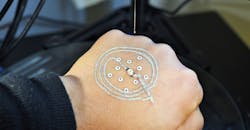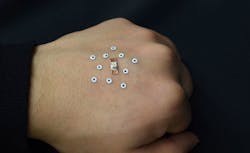The Future of 3D Printing on Human Skin
The ability to 3D print different materials has expanded in recent years. Before, 3D printing metals seemed like a ludicrous concept, and now it is one of the leading 3D printing-associated industries. Aviation leaders like Boeing are using 3D-printed metal fasteners in their airplanes to help reduce weight and part lead time. 3D printing as an engineering field continues to push boundaries; in fact, last month marked the first time someone was able to 3D print electronics directly on to human skin.
3D Printing on Human Skin
Researchers at the University of Minnesota used a customized 3D printer to print electronics directly onto a real hand. The research was published in the Advanced Materials academic journal in April.
Conventional 3D printing technologies typically rely on open‐loop, calibrate‐then‐print operation procedures. The new technique uses adaptive 3D printing, a closed‐loop method that combines real‐time feedback control and direct ink writing of functional materials onto moving freeform surfaces. The hybrid fabrication procedure combines 3D printing of electrical connects with automatic pick‐and‐placing of surface‐mounted electronic components. Using this same approach, the team was also able to successfully print biological cell‐laden hydrogels cells on the skin wound of a mouse.
One of the key innovations of the new 3D-printing technique on skin is that the printer uses computer vision to track and adjust to movements in real time. (Image credit: McAlpine group, University of Minnesota)
“We are excited about the potential of this new 3D-printing technology using a portable, lightweight printer costing less than $400,” said Michael McAlpine, the study's lead author and the University of Minnesota Benjamin Mayhugh Associate Professor of Mechanical Engineering. “We imagine that a soldier could pull this printer out of a backpack and print chemical sensor or other electronics they need, directly on the skin. It would be like a ‘Swiss Army knife’ of the future with everything they need all in one portable 3D printing tool.”
For the new technique to work, the team devised a way for the 3D printer to adjust to small movements of the body during printing. The system uses temporary markers, which are placed on the skin, to scan the surface during printing. The printer uses computer vision to make adjustments based on the surface movement in real-time.
“No matter how hard anyone would try to stay still when using the printer on the skin, a person moves slightly and every hand is different,” McAlpine said. “This printer can track the hand using the markers and adjust in real time to the movements and contours of the hand, so printing of the electronics keeps its circuit shape.”
The systems uses temporary markers to track the hand movements during the printing process to adjust for human movements during the printing process. (Image credit: McAlpine group, University of Minnesota)
The 3D printing technique uses a specialized ink made of silver flakes that cure and conduct at room temperature. Other 3D printing inks need to cure at high temperature of up to 100℃ that would burn one’s hand. To remove the 3D-printed features from the skin, the user can simply peel them off with tweezers or wash it off with water.
Potential for 3D Printing on Skin
The new technique could lead to new medical treatments and on-site use cases. For one, the team believes that it would be possible to print temporary sensors on soldiers in the battlefield to detect chemical and biological agents. The technology could be used to print solar cells to charge electronics, or even used to heal wounds by printing grafts directly on to a person’s skin.
The team partnered with the University of Minnesota Department of Pediatrics to print cells on living tissue. Doctor and medical school Dean Jakub Tolar, a world-renowned expert in treating rare skin diseases, helped the team print bioink cells on the mouse skin wound. This could lead to advanced treatments for patients suffering from skin diseases.
“I'm fascinated by the idea of printing electronics or cells directly on the skin,” McAlpine said. “It is such a simple idea and has unlimited potential for important applications in the future.”



